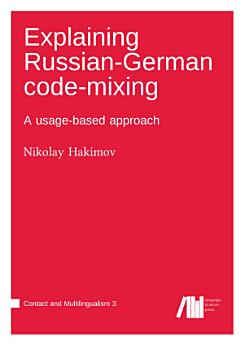Explaining Russian-German code-mixing
Nikolay Hakimov
gen. del 2021 · Contact and Multilingualism Llibre 3 · Language Science Press
Llibre electrònic
306
Pàgines
family_home
Apte
info
reportNo es verifiquen les puntuacions ni les ressenyes Més informació
Sobre aquest llibre
The study of grammatical variation in language mixing has been at the core of research into bilingual language practices. Although various motivations have been proposed in the literature to account for possible mixing patterns, some of them are either controversial, or remain untested. Little is still known about whether and how frequency of use of linguistic elements can contribute to the patterning of bilingual talk. This book is the first to systematically explore the factor usage frequency in a corpus of bilingual speech. The two aims are (i) to describe and analyze the variation in mixing patterns in the speech of Russia German adolescents and young adults in Germany, and (ii) to propose and test usage-based explanations of variation in mixing patterns in three morphosyntactic contexts: the adjective-modified noun phrase, the prepositional phrase, and the plural marking of German noun insertions in bilingual sentences. In these contexts, German noun insertions combine with either Russian or German words and grammatical markers, thus yielding mixed bilingual and German monolingual constituents in otherwise Russian sentences, the latter also labelled as embedded-language islands. The results suggest that the frequency with which words are used together mediates the distribution of mixing patterns in each of the examined contexts. The differing impacts of co-occurrence frequency are attributed to the distributional and semantic specifics of the analyzed morphosyntactic configurations. Lexical frequency has been found to be another important determinant in this variation. Other factors include recency, or lexical priming, in discourse in the case of prepositional phrases, and phonological and structural similarities and differences in the inflectional systems of the contact languages in the case of plural marking.
Sobre l'autor
Nikolay Hakimov is an assistant professor of Slavic Linguistics at the University of Bamberg. He completed his PhD at the University of Freiburg and subsequently worked at the University of Innsbruck. In his research, he focuses on social and cognitive aspects of linguistic variability and dynamicity. He is particularly interested in Slavic languages, multilingualism, spoken language, sound patterns of Slavic and their historical development. Among his recent publications is the special issue of The International Journal of Bilingualism dedicated to fused lects and their emergence (edited together with Peter Auer). He is currently working on a study exploring the prosodic features of the Old Novgorod dialect.
Puntua aquest llibre electrònic
Dona'ns la teva opinió.
Informació de lectura
Telèfons intel·ligents i tauletes
Instal·la l'aplicació Google Play Llibres per a Android i per a iPad i iPhone. Aquesta aplicació se sincronitza automàticament amb el compte i et permet llegir llibres en línia o sense connexió a qualsevol lloc.
Ordinadors portàtils i ordinadors de taula
Pots escoltar els audiollibres que has comprat a Google Play amb el navegador web de l'ordinador.
Lectors de llibres electrònics i altres dispositius
Per llegir en dispositius de tinta electrònica, com ara lectors de llibres electrònics Kobo, hauràs de baixar un fitxer i transferir-lo al dispositiu. Segueix les instruccions detallades del Centre d'ajuda per transferir els fitxers a lectors de llibres electrònics compatibles.







